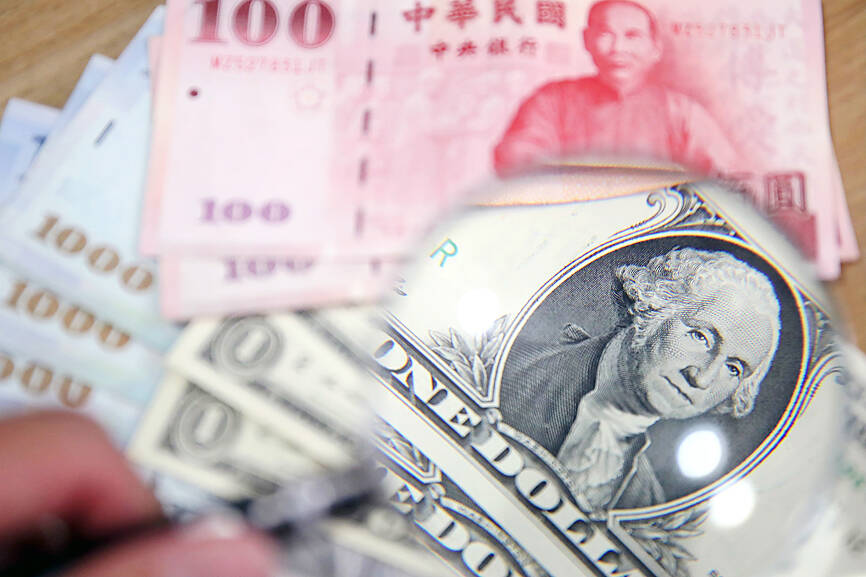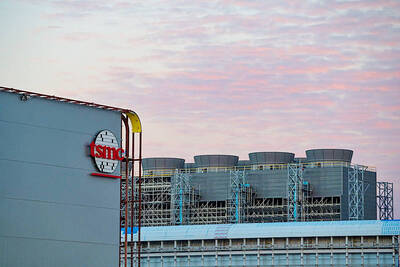The New Taiwan dollar plunged almost 10 percent against the US dollar last year, the steepest decline in 25 years, as the greenback was bolstered by aggressive interest rate hikes by the US Federal Reserve.
The NT dollar closed at NT$30.708 against the greenback on Friday, the last trading session of the year, down NT$3.018, or 9.83 percent, for the year.
That was the local currency’s steepest drop against the US dollar since 1997, when it tumbled NT$5.147, or 15.77 percent, to close at NT$32.638.

Photo: CNA
On the back of Taiwan’s strong exports and sound economic fundamentals, the NT dollar extended its momentum from 2021, when the currency rose 2.95 percent against the US dollar, into early last year to hit a closing high of NT$27.607 on Jan. 17.
However, the greenback rallied after that, helped by expectations of sustained interest rate hikes by the Fed, and it rose to its closing high for the year against the NT dollar at NT$32.245 on Nov. 2.
Taishin International Bank (台新銀行) head currency strategist Chen Yu-chung (陳有忠) said it was rare for the NT dollar to fall more than NT$4 against the US dollar within one year, as it did from NT$27.690 at the end of 2021 to the Nov. 2 closing level.
Chen said the volatility partly came from a hawkish Fed, whose interest rate hikes to stem inflation led to a stronger US dollar and a fund outflow from Asia, hurting the NT dollar, the yen, the yuan and the won.
The NT dollar’s fall was steeper than the yuan’s 8.25 percent fall and the won’s 5.99 percent drop, but smaller than the yen’s 12.87 percent decline last year.
Dealers said the fund outflow also caused the TAIEX to plunge 22.4 percent last year, which put pressure on the NT dollar.
Other factors hurting the local currency were geopolitical risks caused by Russia’s invasion of Ukraine, North Korea’s missile testing and escalating tensions across the Taiwan Strait, Chen said.
However, the NT dollar last month showed signs of stabilizing, pulling back some of its losses against the US dollar by the end of the year.
The rebound, which was also seen in the local stock market, came as investors anticipated that the US central bank would slow its pace of rate hikes as inflation pressures seemed to ease and fears of a recession grew.
At a policymaking meeting last month, the Fed raised its key interest rates by 50 basis points, a smaller hike than the 75-basis point increases seen after each of its four previous meetings.
Since March last year, the US central bank has raised interest rates by 425 basis points.
“To the Taiwan dollar, the landmine of a strong US dollar has been removed. As the Fed’s rate hike cycle comes to an end in 2023, the Taiwan dollar is expected to stay stable and will likely rebound,” Chen said.
However, room for the NT dollar to appreciate would be limited, as Taiwan is expected to continue to face cross-strait tensions, which could keep foreign institutional investors from buying into the local currency.
The NT dollar could also be held back by the impact of weakening global demand on Taiwan’s economy as exporters’ outbound sales fall and have fewer US dollars to exchange to local currency.
When Taiwan’s exports fell 13.1 percent year-on-year in November, it was the third consecutive monthly drop and the biggest year-on-year monthly drop in about seven years, the Ministry of Finance said.
The NT dollar is expected to move between NT$30 and NT$31 against the US dollar this year, and it would be unlikely to challenge the NT$29 level, dealers said.

Shiina Ito has had fewer Chinese customers at her Tokyo jewelry shop since Beijing issued a travel warning in the wake of a diplomatic spat, but she said she was not concerned. A souring of Tokyo-Beijing relations this month, following remarks by Japanese Prime Minister Sanae Takaichi about Taiwan, has fueled concerns about the impact on the ritzy boutiques, noodle joints and hotels where holidaymakers spend their cash. However, businesses in Tokyo largely shrugged off any anxiety. “Since there are fewer Chinese customers, it’s become a bit easier for Japanese shoppers to visit, so our sales haven’t really dropped,” Ito

The number of Taiwanese working in the US rose to a record high of 137,000 last year, driven largely by Taiwan Semiconductor Manufacturing Co’s (TSMC, 台積電) rapid overseas expansion, according to government data released yesterday. A total of 666,000 Taiwanese nationals were employed abroad last year, an increase of 45,000 from 2023 and the highest level since the COVID-19 pandemic, data from the Directorate-General of Budget, Accounting and Statistics (DGBAS) showed. Overseas employment had steadily increased between 2009 and 2019, peaking at 739,000, before plunging to 319,000 in 2021 amid US-China trade tensions, global supply chain shifts, reshoring by Taiwanese companies and

Taiwan Semiconductor Manufacturing Co (TSMC, 台積電) received about NT$147 billion (US$4.71 billion) in subsidies from the US, Japanese, German and Chinese governments over the past two years for its global expansion. Financial data compiled by the world’s largest contract chipmaker showed the company secured NT$4.77 billion in subsidies from the governments in the third quarter, bringing the total for the first three quarters of the year to about NT$71.9 billion. Along with the NT$75.16 billion in financial aid TSMC received last year, the chipmaker obtained NT$147 billion in subsidies in almost two years, the data showed. The subsidies received by its subsidiaries —

Taiwan Semiconductor Manufacturing Co (TSMC) Chairman C.C. Wei (魏哲家) and the company’s former chairman, Mark Liu (劉德音), both received the Robert N. Noyce Award -- the semiconductor industry’s highest honor -- in San Jose, California, on Thursday (local time). Speaking at the award event, Liu, who retired last year, expressed gratitude to his wife, his dissertation advisor at the University of California, Berkeley, his supervisors at AT&T Bell Laboratories -- where he worked on optical fiber communication systems before joining TSMC, TSMC partners, and industry colleagues. Liu said that working alongside TSMC